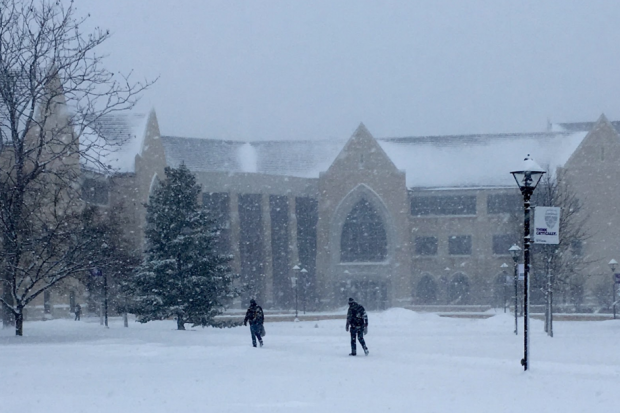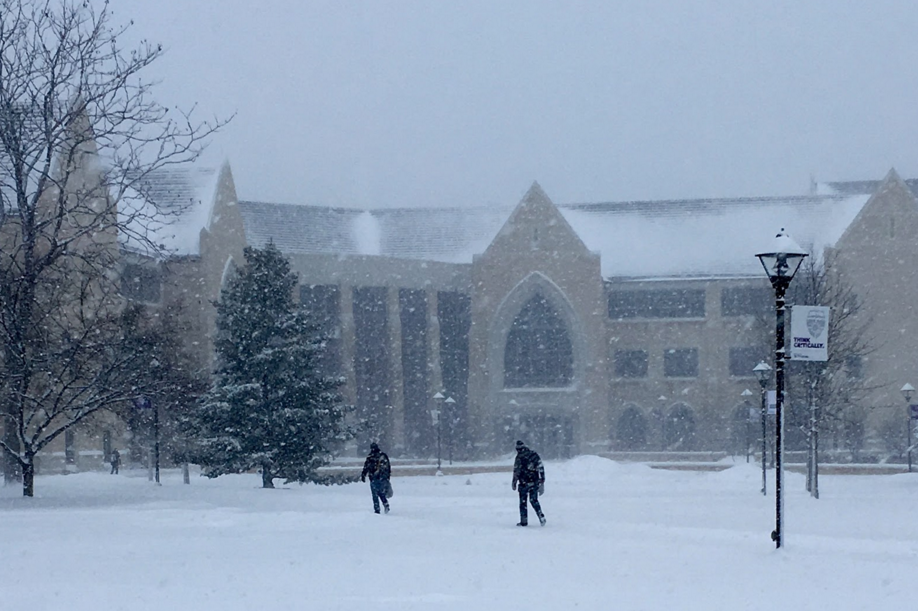
It’s hard to imagine the campus lush with green grass in February. Nevertheless, after the winter, the pristinely groomed green grass will spring up again, with help from pesticides and fertilizers.
St. Thomas is contracted with ProTurf, a landscape and lawn care company, which helps keep the lawns green by applying fertilizers and weed controllers to St. Thomas grass three times a year.
According to St. Thomas Grounds Supervisor Roger Weinbrenner, ProTurf was chosen to be the university’s provider of pesticides and fertilizers many years ago during a bidding process. He said ProTurf has always been a reliable service.
“They have done a great job of servicing our campus on weekends and early mornings as to limit interference with campus events and activities,” Weinbrenner said. “We send out a request for bids annually for this process and will be doing so again in the next month.”
But these grass greening treatments are not without controversy.
“Some [fertilizers] contain nitrogen and phosphorus, and basically what’s happening is we have a drain here on campus that leads directly to the Mississippi River,” said Senior Abigail Lukowicz, co-president of the St. Thomas Sustainability Club.
These chemicals can have environmental impacts farther downstream, according to Adam Kay, an environmental science professor at St. Thomas.
“If the land is rich with fertilizer, then it results in algae blooms on the surface of the water. When (algae blooms) die they will drift to the bottom, and as they are doing that they will decompose. During decomposition, they take up oxygen from the water so they make it hypoxic, which just means low oxygen… It creates what is called a dead zone,” Kay said.
According to ProTurf Division Manager of Commercial Lawn Sales and Service Dan Inserra, the products used on St. Thomas’ grass do contain nitrogen but not phosphorous. And Inserra said they aren’t as harmful as people think.
“There is no major concern for anyone to worry about. Especially getting three applications a year. It’s not anything that’s going to hurt anybody or anything,” Inserra said referencing the three annual treatments St. Thomas grass receives. “If it would be sprayed when there’s a torrential downpour of rain, which we’re not going to do, then it would more than likely run out and get into the sewers and things like that.”
Inserra also said the amount of chemicals used on St. Thomas’ grass isn’t enough to do any major harm.
“It would take so much more than we’re putting down to do anything in the sewers,” Inserra said. “We may put in, say, 8 ounces per 800 gallons of water.”
Weinbrenner spoke about how important these pesticides and fertilizers are in maintaining St. Thomas’ pristine image.
“It’s like the front door to the campus,” Weinbrenner said. “No matter where they park on campus, the first thing they are going to notice is the appearance of the grounds and grass.”
Senior Nathan Beacom, Lukowicz’s Sustainability Club co-president, agreed with Weinbrenner that the grass should be aesthetically pleasing. However, he thinks there are more sustainable ways of keeping it green.
“It’s like people are scared to see a dandelion or a weed,” Beacom said. “There are ways to balance keeping the campus looking like we want it to and to be sustainable at the same time.”
Kay said he actually sees beauty in naturally occurring dandelions and clovers.
“If we could say, ‘Let’s make mixed grasses; let’s have diverse plantings out there,’ then the dandelions would be part of it, but wouldn’t dominate,” Kay said. “You could have clovers that actually have clover flowers that actually have bees visiting them. Instead of this sterile environment, it could actually be this living landscape.”
The university typically uses a single type of grass, Kentucky bluegrass, which provides the ultimate aesthetic for a campus because it is richly green and pristine. But its upkeep comes at a cost to the environment when using synthetic fertilization processes that Kay thinks St. Thomas could work around.
“To deal with the synthetic part we could use compost. There are a variety of different ways of doing that,” Kay said. “We could contribute to the local economy by using locally produced compost for the grasses here.”
The grounds and biology departments are always looking for greener and more efficient options, Weinbrenner said. They hope to experiment with different lawn-care methods and find one that is both effective and environmentally friendly when they send out their annual bid for service providers next month.
Marissa Groechel can be reached at groe5630@stthomas.edu.


“the dandelions would be part of it, but wouldn’t dominate” – not a chance!
If the amount of chemicals used isn’t enough to do any major harm then why do the signs say pets and children stay off the grass for x-hours? I understand liability but I think “major harm” is a stretch. How many children from CDC need to breathe in the chemicals and how many students need to have allergic reactions before they deem the chemicals harmful enough?
Thank you for writing about this issue, it seems like something that isn’t spoken about often enough.